Small Space Front Yard Landscaping: Making a Big Statement in a Limited Space
Does the small size of your front yard make it feel… underwhelming? Maybe it’s just a patch of grass. Perhaps some tired shrubs hug the foundation. You dream of fantastic small front yard landscaping curb appeal. But reality feels cramped. Limited. Boring even. You look at your neighbour’s place. Then back at yours. Sigh. That potential just sits there, unrealized.
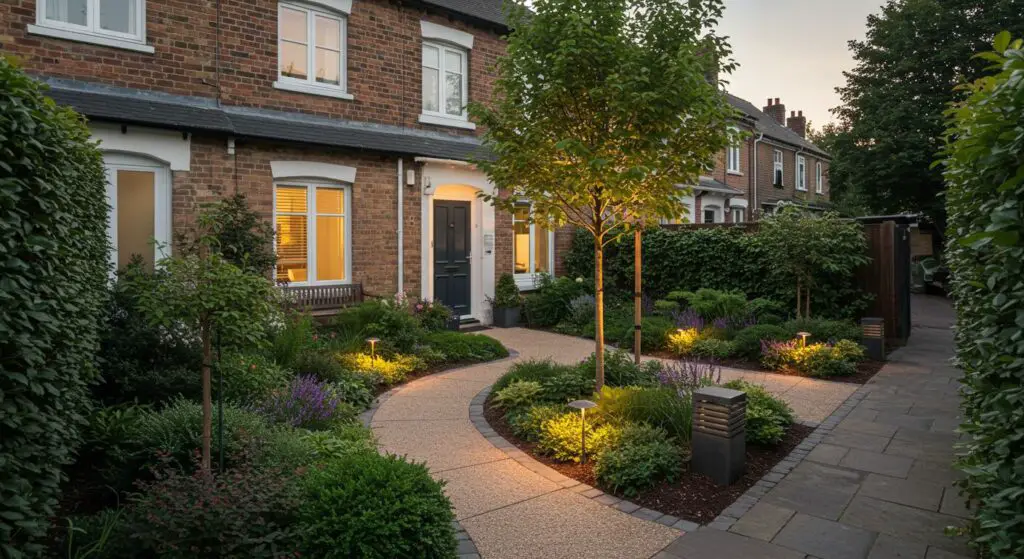
The Small Front Yard Paradox
Many homeowners face this challenge. Limited space is common. Narrow lots squeeze houses together. Sometimes the house itself feels small for the plot. Or maybe neighbours seem too close for comfort. Common mistakes happen. People often default to a tiny square of lawn. Or they plant shrubs that quickly outgrow their welcome, blocking windows. Sound familiar?
But what if that small space isn’t a problem? What if it’s an opportunity? Think of your front yard like a jewel box. It’s a space for concentrated impact. A place where every detail shines. Quality over sheer size becomes the goal. Every square inch can be made beautiful. Purposeful.
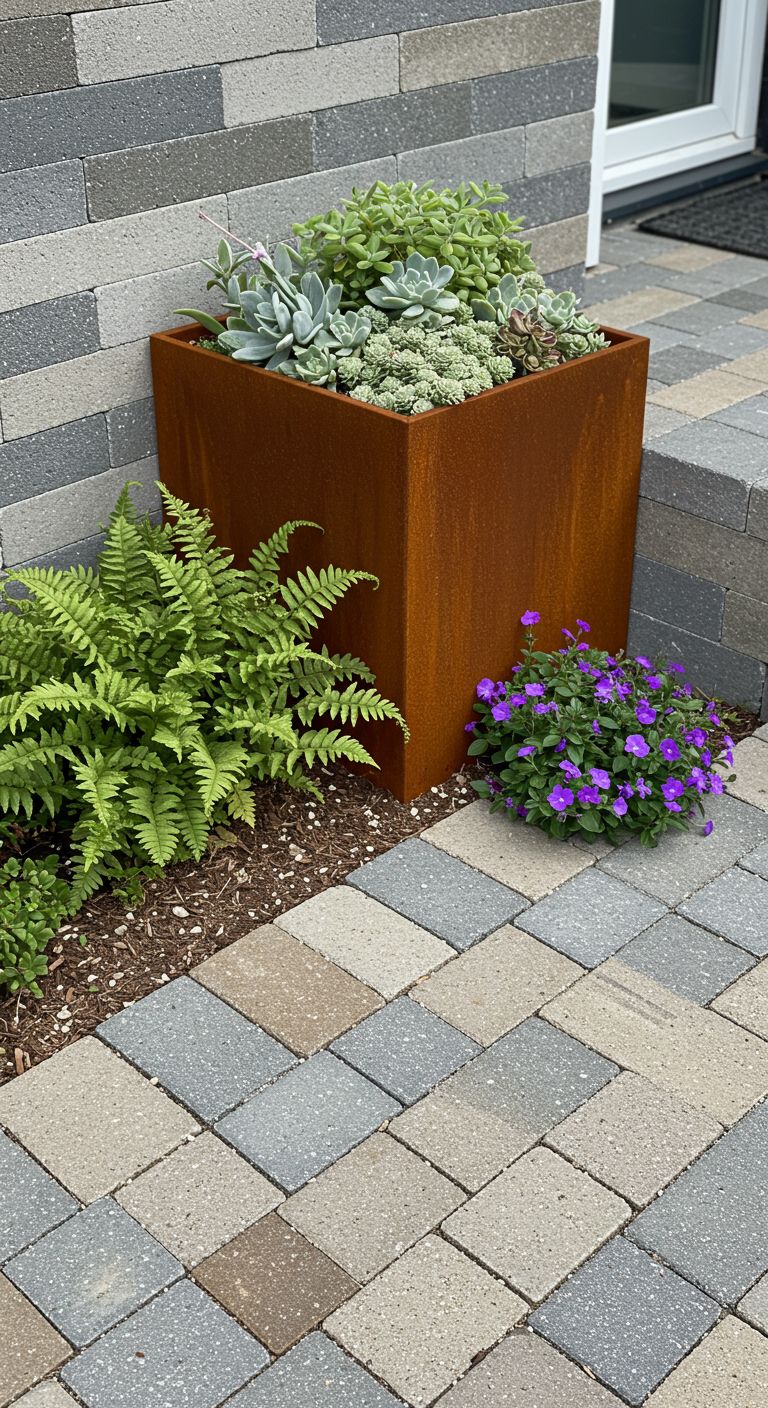
This article is your guide. We will share smart strategies. Achievable ideas are coming your way. We’ll cover design tips. We’ll look at planting choices. Hardscaping options too. Even some DIY projects. All focused on maximizing beauty. Function matters. And boosting that front yard small house landscaping appeal is key. Get ready to create a front yard that truly welcomes you home. A yard that makes a big statement.
Mindset Shift: Thinking Big in Small Spaces
Okay, let’s talk about how to think about your small yard. Everyone says “go vertical.” And yes, planting upwards helps save ground space. But maximizing your yard is more than just planting tall, skinny trees. It’s about the whole experience. How does the space feel when you walk up to your door?
Focus on quality over quantity. One stunning plant can have more impact than ten mediocre ones jammed together. Fewer, well-chosen elements feel intentional. Not cluttered. Think carefully about each choice. Does it add real value? Or just fill space?
Small spaces are perfect for appreciating details. Intricate paving patterns catch the eye. Unique plants with interesting textures invite a closer look. Think fuzzy leaves. Or shiny ones. Or spiky shapes. Well-crafted features like a unique gate handle stand out. People notice these things up close.
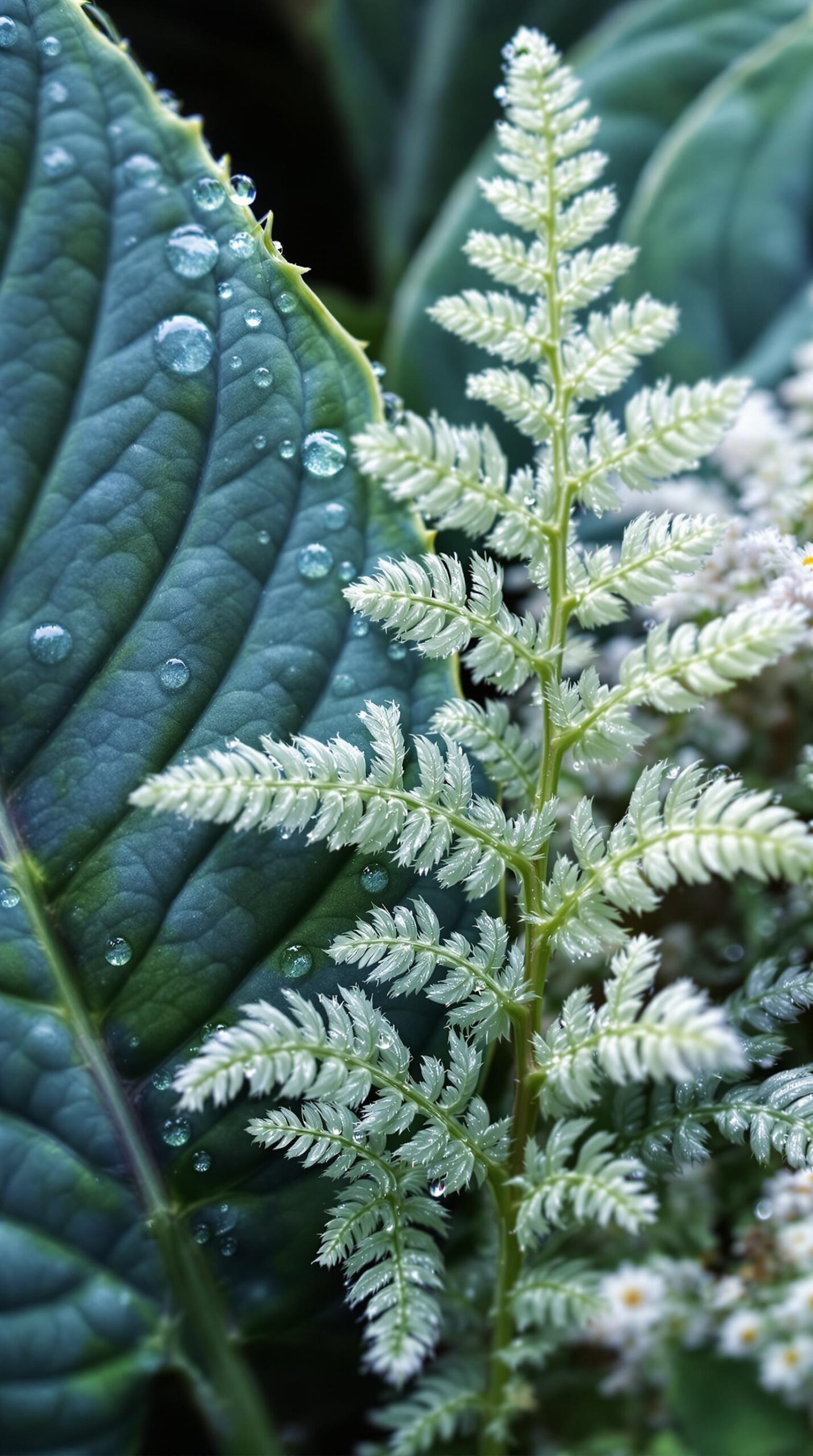
Your small front yard landscaping design should connect to your house. Look at your home’s style. Its architecture. Its scale. The landscape should feel like a natural extension. Not something separate. Aim for a unified look. This connection is super important when everything is close together on a small lot.
And let’s move past some old ideas. Forget needing perfectly matched shrubs on each side of the door. Or only using tiny dwarf evergreens. Those can look dated. Or just plain dull. We want dynamic. Interesting. Let’s explore ideas beyond the usual suspects. Your small front yard landscaping ideas can be much more creative!
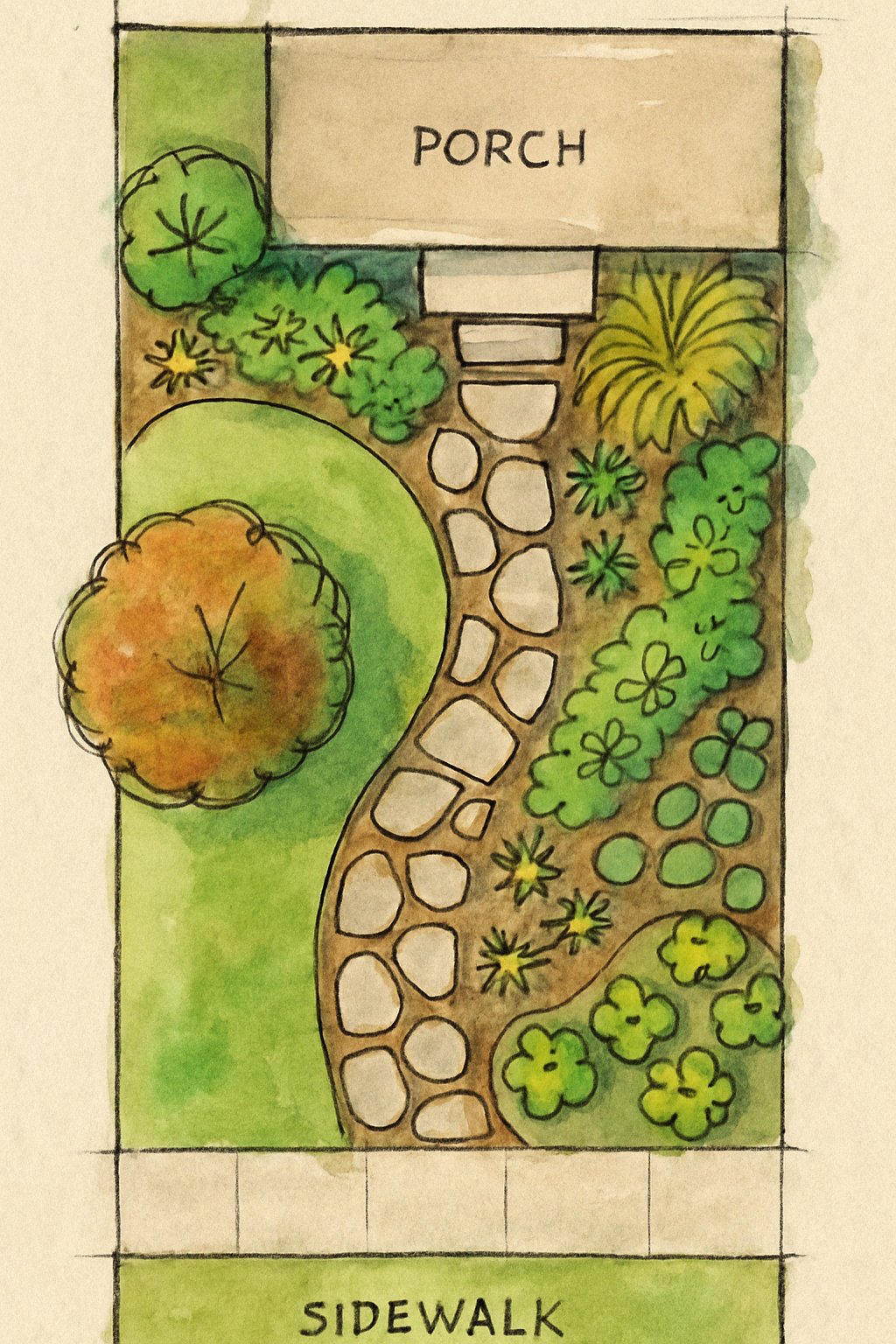
Core Design Principles Tailored for Tight Quarters
Good design makes small spaces feel special. Not just bigger. Special. Certain tricks guide the eye. They create a pleasant flow. Let’s look at the core ideas for your small front yard landscaping design.
Creating Flow and Illusion of Space
How you move through the yard matters. Even a short walk can feel interesting.
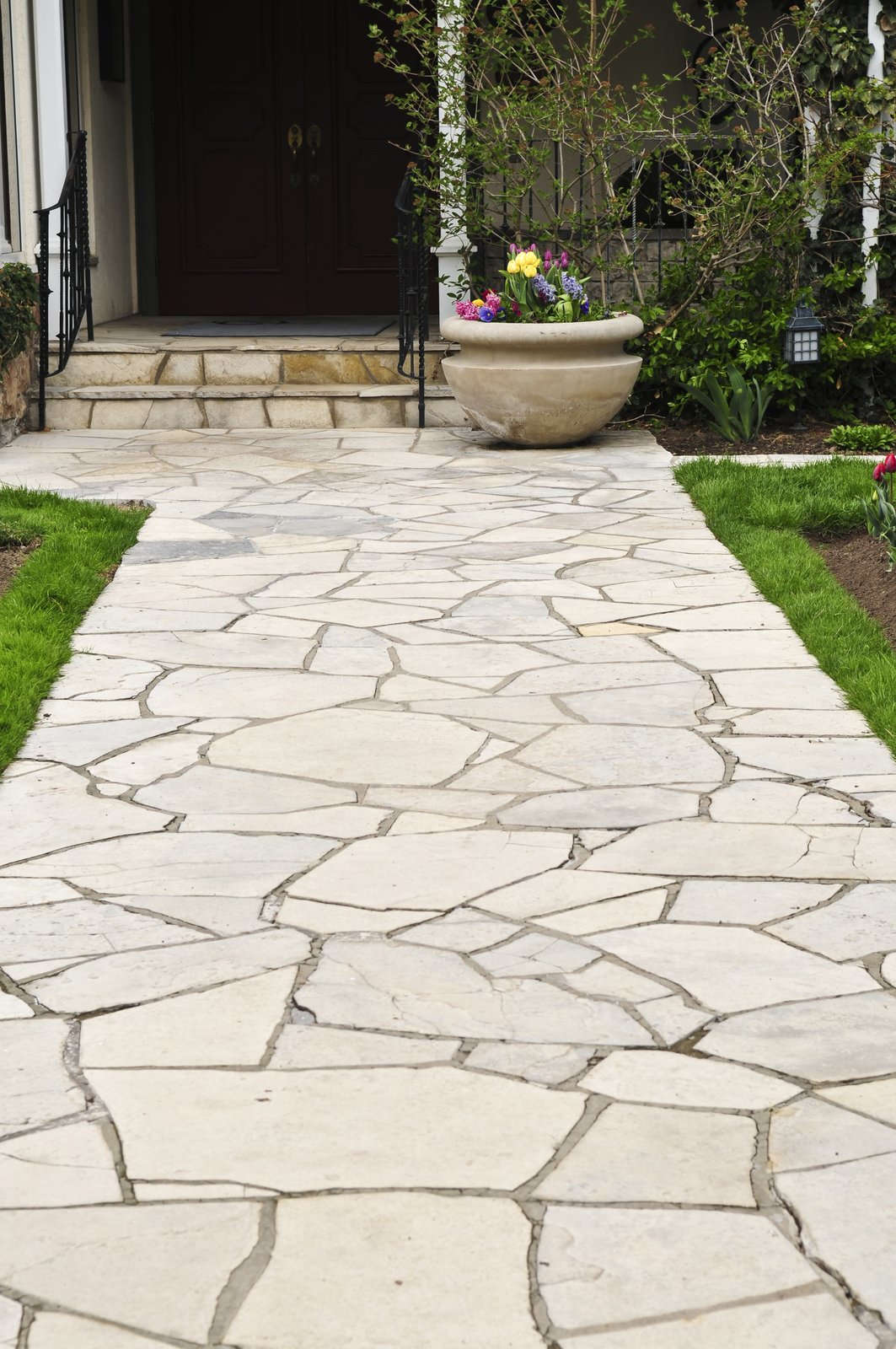
- Pathways with Purpose
A straight shot to the door can feel abrupt. Especially in a small area. Consider a curved path. Or maybe one set on a diagonal. These lines make the journey feel a little longer. More engaging. Think beyond basic concrete. Permeable pavers look great and help with drainage. Gravel paths with unique stepping stones add charm. Patterned brick offers classic style. Your path is a major design element. - Layering for Depth
Don’t line everything up flat against the house. Think in layers. Put taller plants towards the back (near the house or fence). Place medium-sized plants in the middle. Put the shortest ones right up front along the path or edge. Varying textures in each layer adds even more dimension. This technique tricks the eye. It makes the space feel deeper than it really is. Your small front yard landscaping layout gains complexity. - Borrowed Views & Sightlines
Look beyond your property lines. Is there a nice tree across the street? A view of distant hills? Frame that view! Use plants or structures like an arbor to create a ‘window’ looking out. You can also direct the eye within your yard. A strategically placed plant or feature can pull attention towards it, making the journey more interesting.
Establishing Focal Points (Without Overcrowding)
Every good design needs a focus. Something that catches the eye. But in a small space, less is more.

- The Singular Statement
Avoid cluttering your yard with too many ‘look-at-me’ items. Choose one or two strong focal points. What could work? Maybe a unique specimen tree with interesting bark or shape (choose one that stays appropriately sized!). A striking sculpture could add personality. A grouping of three architectural planters in different sizes makes a statement. An interesting gate or a small arbor over the start of the path works well too. - The Entry Experience
Your front door area is prime real estate. Make it a key focal zone. Use high-quality planters flanking the door. Add special paving right at the threshold. Ensure lighting highlights the entrance at night. Paint your door a welcoming color. Make arriving at your home feel special. This is a natural place for the eye to land.Picture this: Close-up on a welcoming front entryway. A brightly painted front door (e.g., teal blue) is flanked by two matching, tall, elegant black planters filled with seasonal flowers and trailing vines. An attractive, durable coir doormat sits on a landing paved with intricate brickwork. A stylish overhead light fixture is visible. Warm, inviting atmosphere, sharp focus on details, photorealistic style.
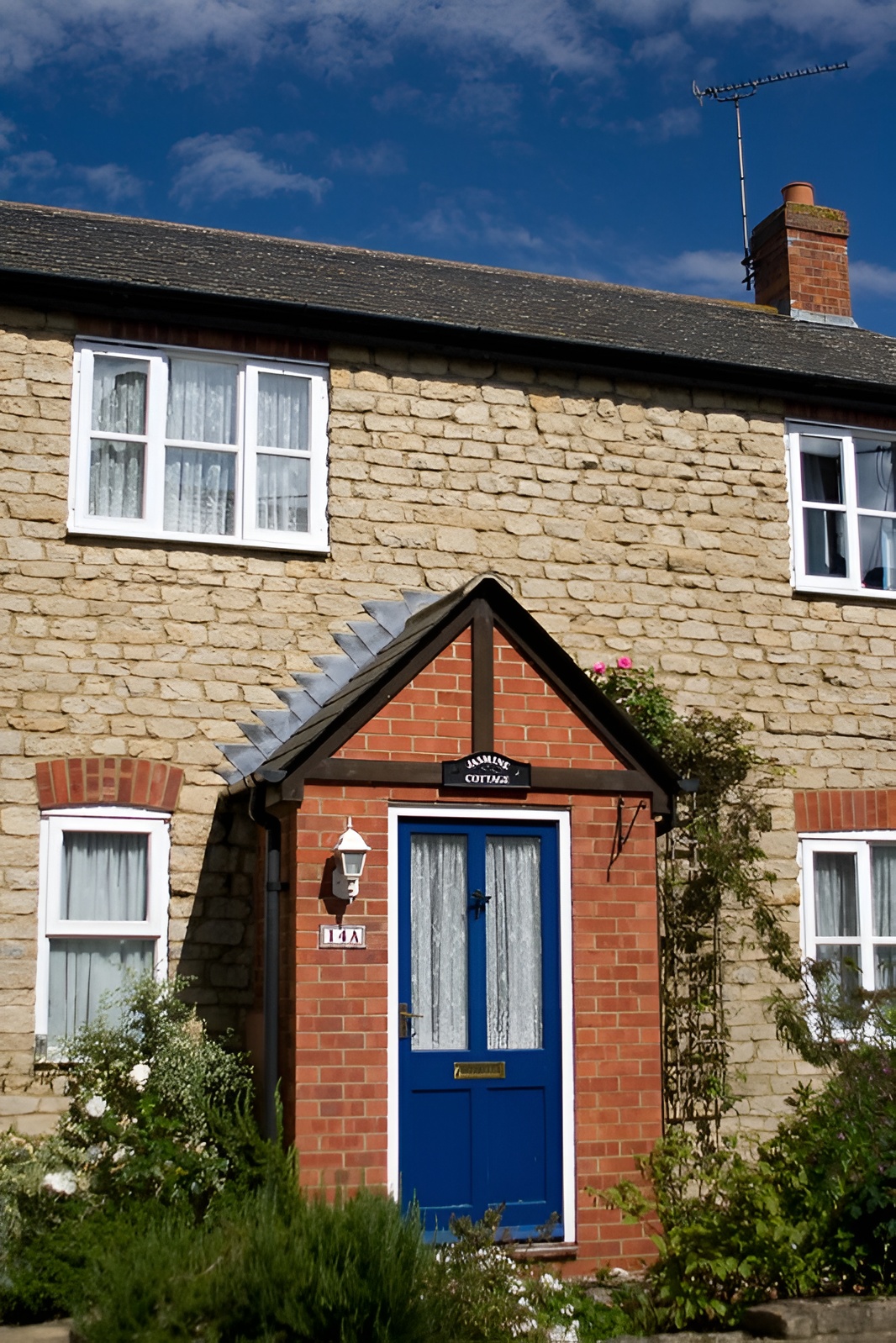
Unity Through Repetition (Subtlety is Key)
Repeating elements helps tie the design together. It creates a cohesive, intentional look. Random planting or materials can feel chaotic in a small space.
- Use repetition subtly. Don’t overdo it. Repeat a specific plant form (like rounded shrubs) in a few spots. Echo a particular flower color. Use the same material for pathways and planter boxes. For example, if you have stone edging, maybe use similar stones around a feature tree. This creates harmony. It makes the small front yard landscaping design layout design feel complete. But avoid making everything identical. That’s monotonous. Aim for rhythm, not robotic repetition.
Planting Palettes: Choosing Plants That Punch Above Their Weight
Plants bring your design to life. But in a small front yard landscaping garden, every plant needs to earn its keep. Choose wisely!
Beyond Foundation Shrubs: The Multi-Taskers
Move past the boring green blobs. Look for plants that offer more.
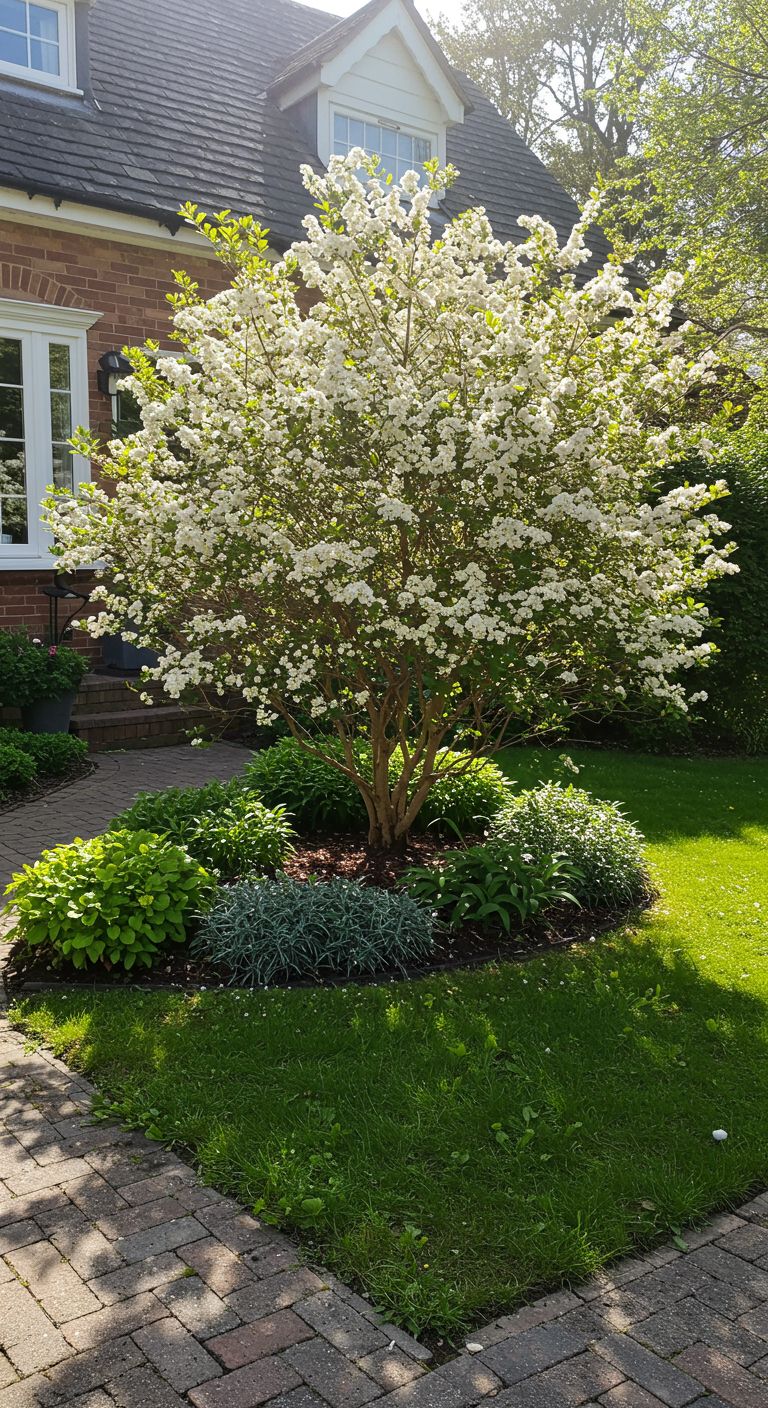
- Focus on plants with multiple seasons of interest. Think great foliage color in spring and fall. Interesting flowers in summer. Maybe berries for birds in winter. Or cool bark texture. Or a strong structure that looks good even when bare. Consider Fothergilla (great fall color, spring flowers). Certain Hydrangeas like Hydrangea paniculata ‘Little Lime’ offer summer flowers and winter structure. Heuchera varieties provide amazing foliage color almost year-round. Ornamental grasses often have winter presence. These hard workers give you more bang for your buck.
- Columnar & Fastigiate Forms
Need height without taking up valuable ground? Look for trees and shrubs with narrow, upright shapes. These are called columnar or fastigiate. They grow tall but stay skinny. Perfect for tight spots or flanking an entrance. Examples include certain cultivars of Hornbeam (like ‘Frans Fontaine’), Juniper (‘Skyrocket’), or Sky Pencil Holly. They draw the eye upward.

Textural Tapestries & Foliage First
Flowers are great. But they come and go. Foliage is often there much longer. Texture adds richness and interest all season.
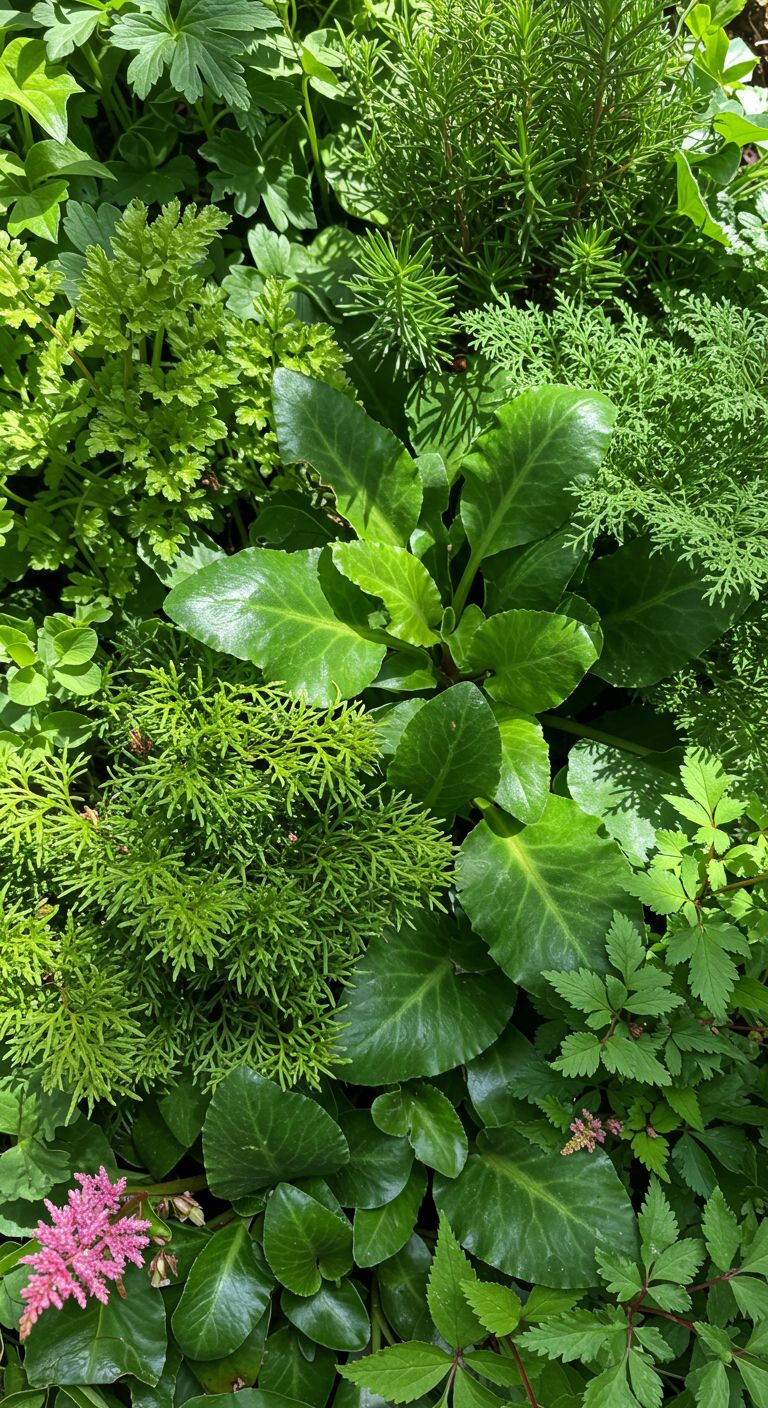
- Mix up leaf shapes, sizes, and textures. Combine bold leaves (like Hosta or Bergenia) with fine textures (like Ferns or Coreopsis ‘Zagreb’). Contrast glossy leaves with matte or fuzzy ones. This interplay creates visual excitement. It keeps the garden interesting even when nothing is blooming. Don’t underestimate the power of foliage!
Groundcover Solutions (Lawn Alternatives)
That tiny patch of grass can be a hassle. Mowing is awkward. It often doesn’t thrive. Consider groundcovers instead for small easy front yard landscaping ideas.
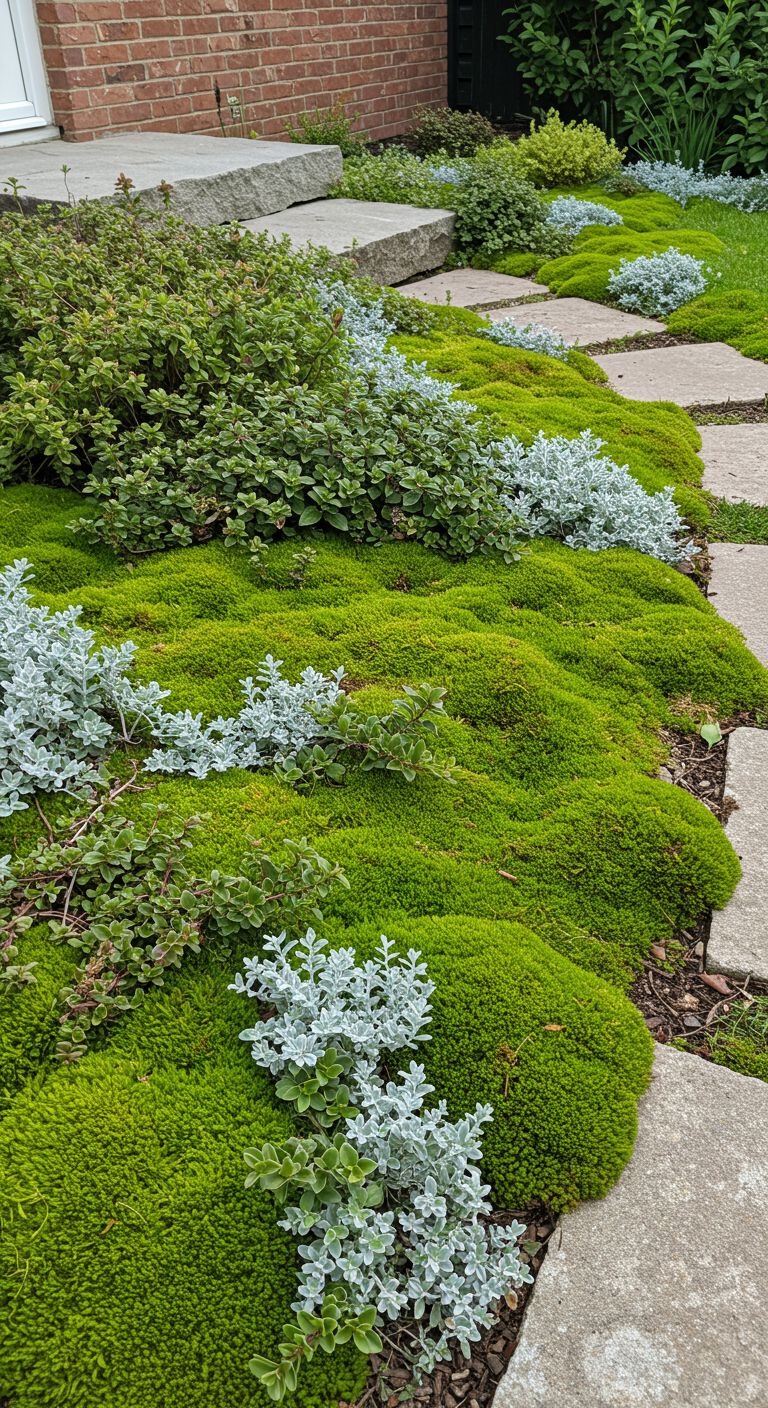
- Many sophisticated groundcovers offer amazing texture and color. And much less work! Mazus reptans forms a flat green mat with tiny purple flowers. Sedum ‘carpets’ come in many colors and are super tough. Creeping Thyme varieties release scent when stepped on (choose walkable types!). Ajuga ‘Chocolate Chip’ has dark leaves and blue flowers. Dwarf Mondo Grass offers a fine-textured, grass-like look without mowing. Check if the area gets foot traffic when choosing. Some tolerate it, others don’t.
Strategic Color Use
Color impacts how we perceive space. Use it smartly.

- Cool colors like blues, purples, and silvers tend to recede. They can make a small space feel a bit larger. Or calmer. Warm colors like reds, oranges, and yellows advance. They grab attention and draw the eye. Use pops of bold, warm color strategically. Maybe near the front door. Or to highlight a focal point. Don’t splash loud color everywhere – it can feel overwhelming. Also, try to harmonize plant colors with your house’s exterior paint or trim. This creates a pulled-together look for your front yard small area landscaping ideas.
Elevated Container Gardening
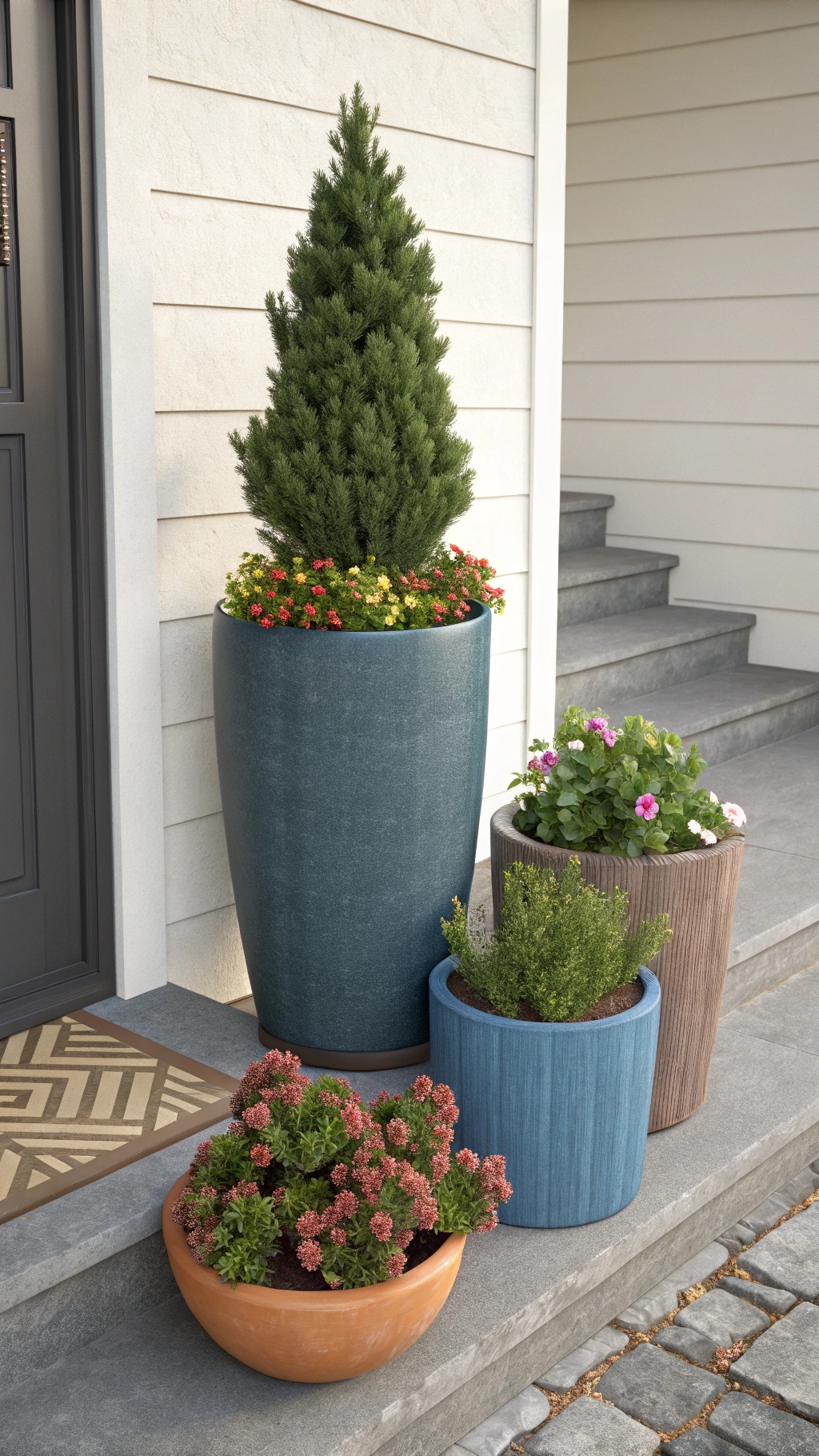
Containers aren’t just for patios. They are powerful design tools for small front yard landscaping ideas low maintenance garden spaces.
Forget cheap plastic pots. Use high-quality containers as design elements. Think about their material (ceramic, metal, concrete, wood), shape, and color. Group containers of varied sizes together for impact. A cluster of three pots – tall, medium, small – looks great. Use them to define the edge of a path. Flank an entranceway. Create a mini-garden on a paved area where planting beds are impossible. You can even grow dwarf trees or larger shrubs in substantial containers for years.
Hardscaping & Features: Structure, Style, and Solutions
Hardscaping refers to the non-living elements in your landscape. Think paths, walls, patios, and features. These elements provide structure. They define spaces. And they add style, especially important in front yard landscaping for small area designs.
Defining the Space: Edging & Borders
Clean lines make a huge difference in small yards. Messy edges make everything look smaller and untidy.
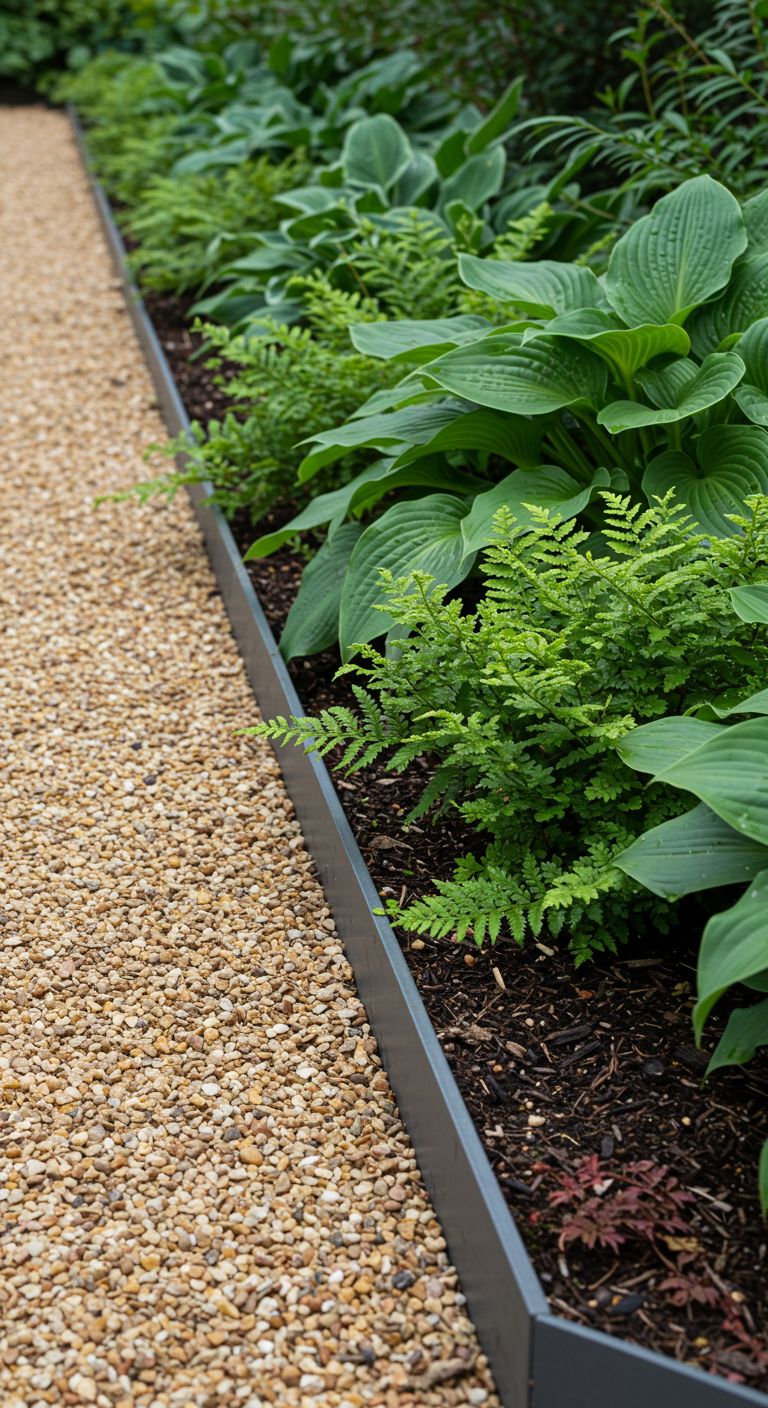
- The power of crisp, clean edges cannot be overstated. Use materials like metal strips (often almost invisible), stone blocks, or bricks to define your garden beds clearly. This creates a neat, intentional look. Well-defined beds visually separate lawn (if any), paths, and planting areas. This separation actually makes the whole space feel larger and more organized. It’s a simple detail with big impact.
Smart Surfaces
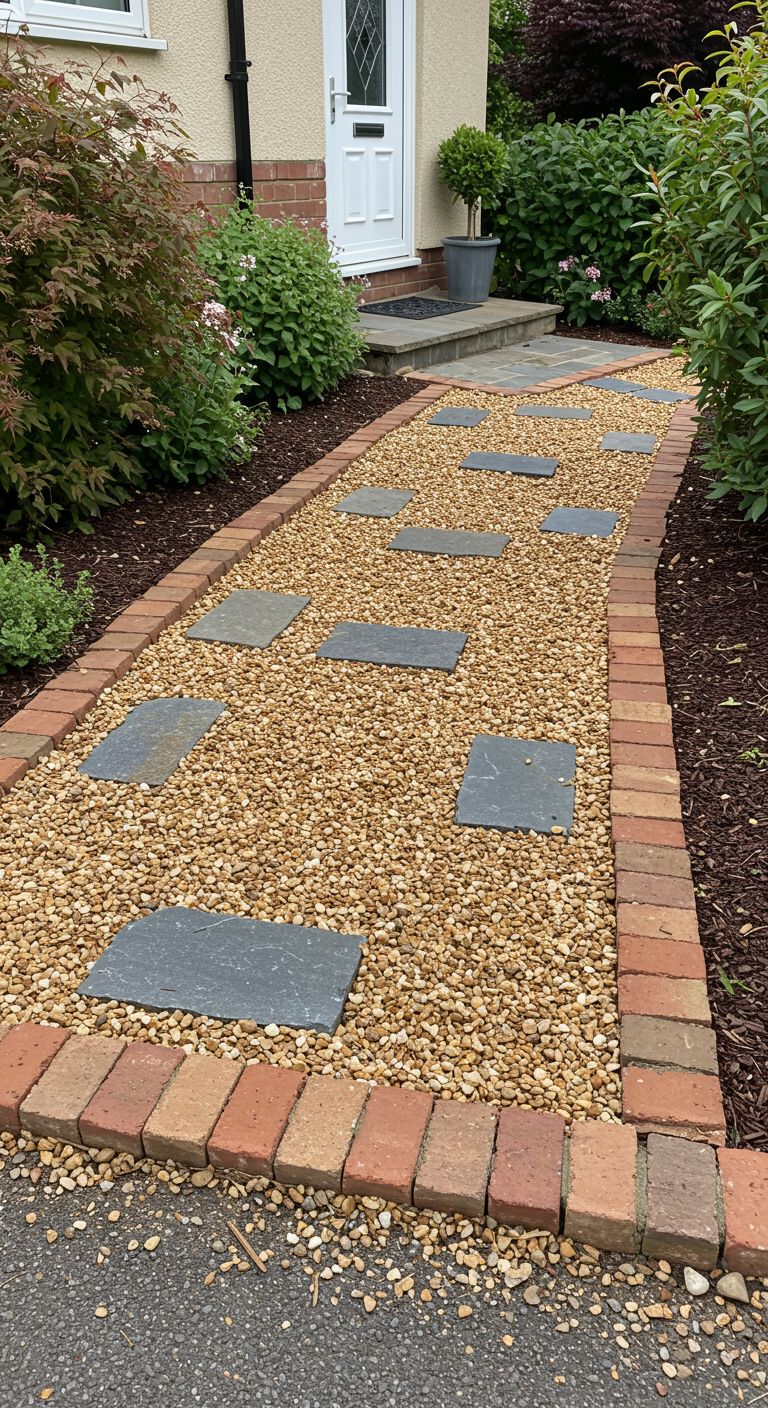
Your pathways and any small patio areas need careful thought. Choose materials that work hard and look good.
- Consider permeable paving options. These allow rainwater to soak through, which is better for the environment and can reduce puddles. Options include permeable pavers, gravel, or specially designed grids. Combining materials adds interest too. Maybe a gravel path with smooth river stone accents? Or brick edging along a paver walkway? Even small decking platforms or low landings can create distinct ‘zones’. A tiny raised platform can feel like a separate room, adding dimension.
Incorporating Seating (Subtly)
Adding a place to sit makes your front yard feel more like a garden. More welcoming. Not just something to walk past.
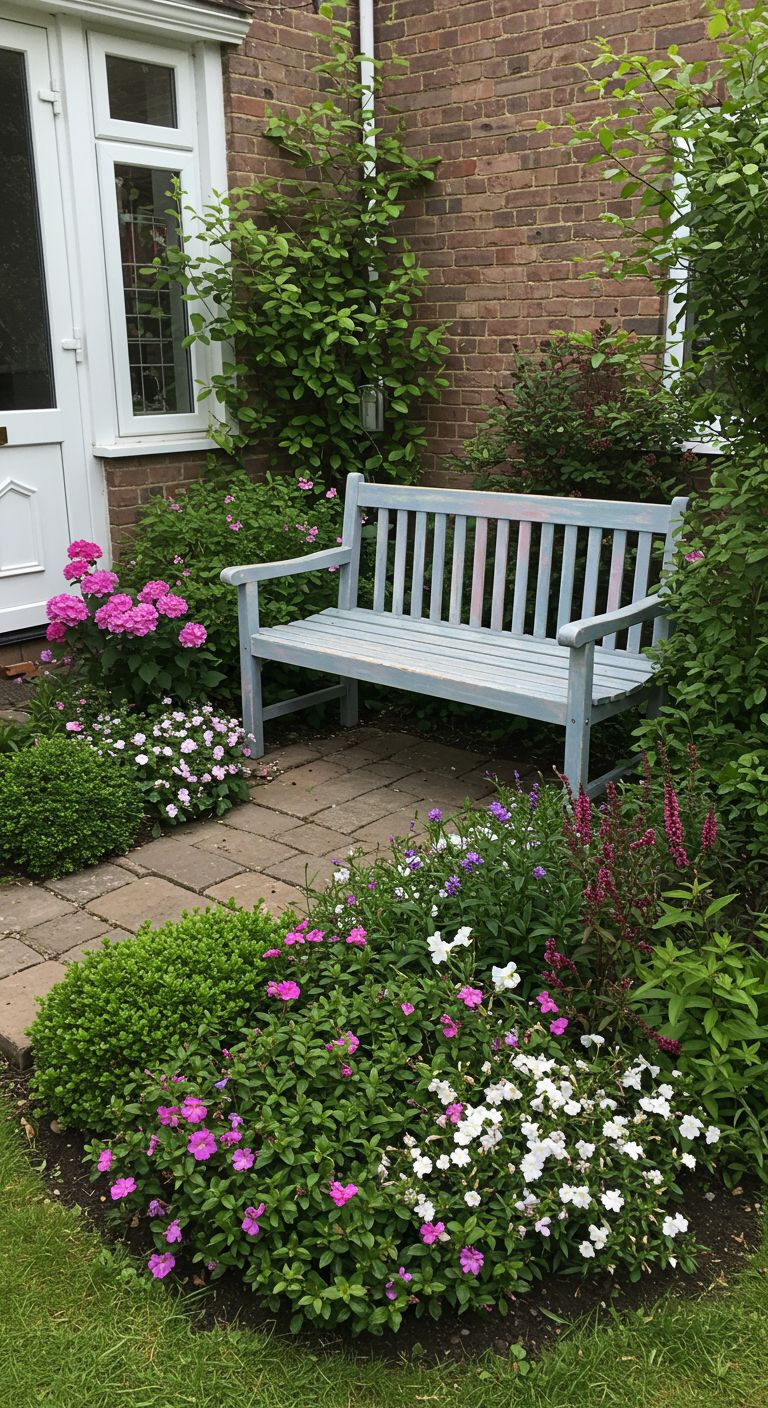
- You don’t need a full patio set. Think subtle. A single, well-placed bench nestled amongst plants invites a pause. Maybe seating integrated into a low retaining wall? Or just a stylish pair of weather-resistant chairs near the entrance? Choose furniture scaled appropriately for the space. Avoid bulky items. Seating transforms the yard from purely decorative to usable space. Even if you rarely sit there, it signals welcome.
Scaled Water Features & Sound
The sound of water adds a wonderful sensory element. And you don’t need a giant fountain.
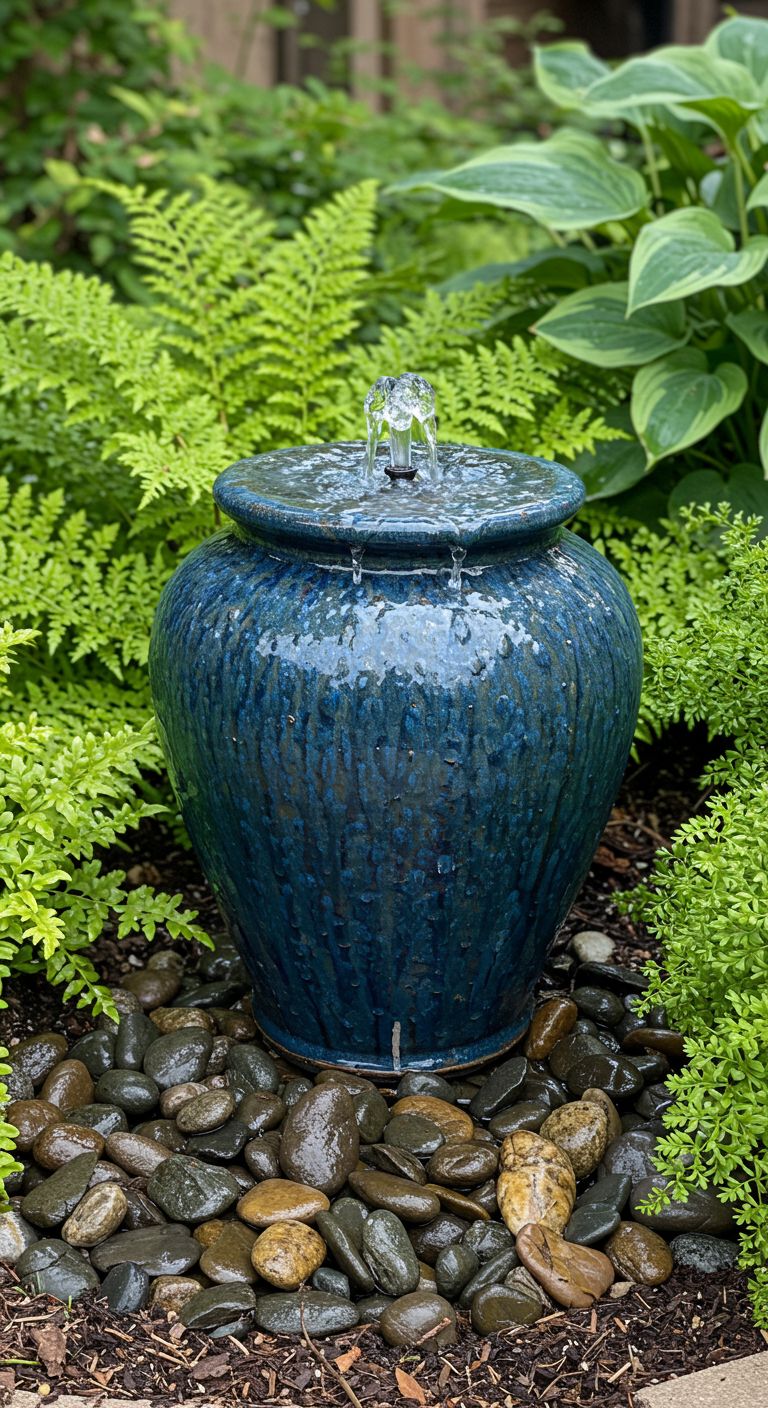
- Small water features work beautifully. Consider a bubbling urn fountain where water gently spills over the sides. Or a wall fountain mounted on a fence or house wall. Disappearing fountains, where water vanishes into a gravel bed below, are great for safety and space-saving. The gentle sound can also help mask unwanted street noise, making your small yard feel more serene.
Lighting for Drama and Safety
Landscape lighting transforms your yard after dark. It adds ambiance. And it improves safety.

- Subtlety is key. Use low-voltage landscape lighting strategically. Path lights guide footsteps safely along walkways. Uplighting a beautiful specimen tree creates dramatic shadows and highlights its form. Washing a textured wall with light can add depth. Focus on warm white light, which generally feels more welcoming than cool blue tones. Good lighting extends the enjoyment of your small front yard landscaping ideas into the evening.
Addressing Specific Challenges & Needs
Small yards often come with specific challenges. Narrow shapes. Lack of privacy. Slopes. Or the need for low maintenance. Let’s tackle these common issues.
The Narrow Front Yard
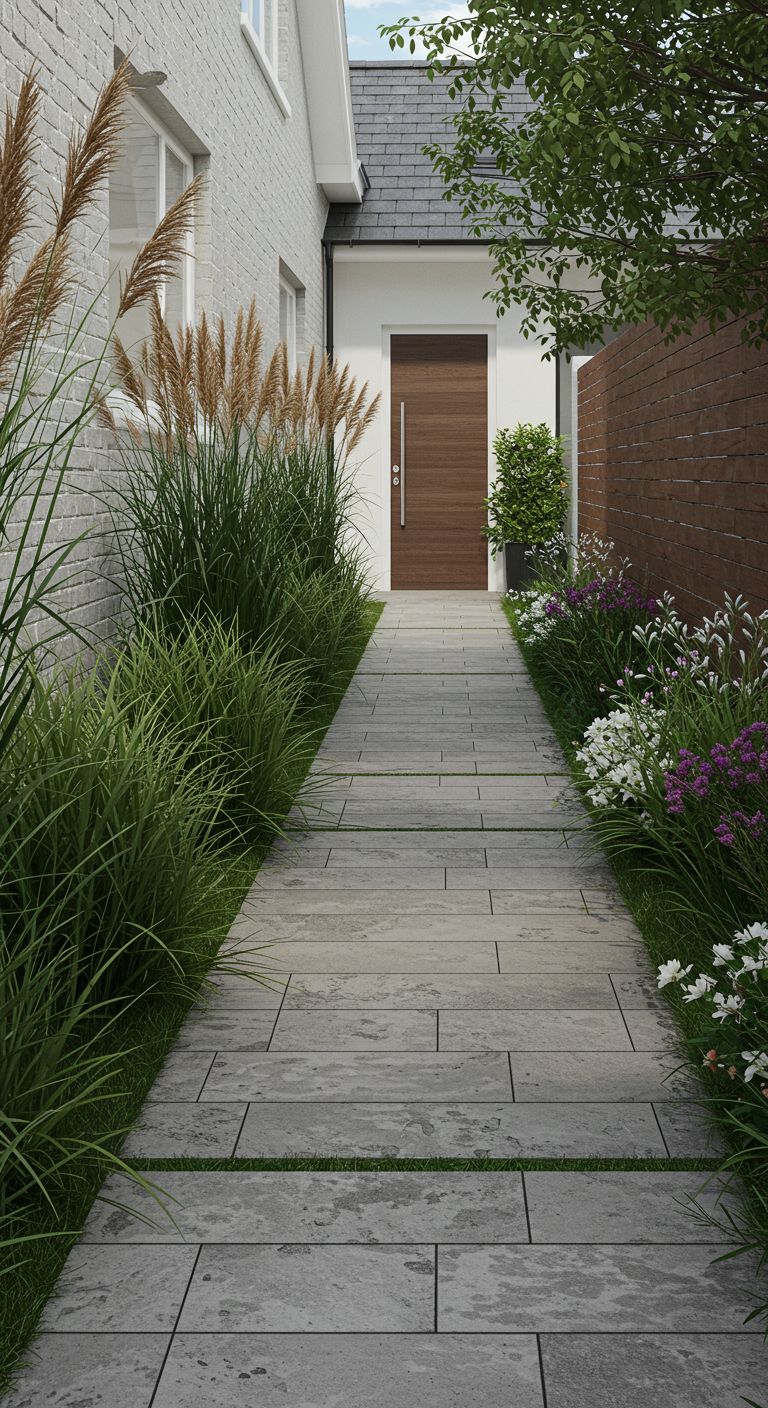
Does your yard feel like a bowling alley leading to the front door? There are ways to fight that feeling.
- Emphasize vertical lines cleverly. Use tall, narrow plants (columnar types). If possible, echo vertical siding on your house with vertical elements in the landscape, like a tall planter or trellis. Break up the long, straight path. Use a diagonal layout. Or gentle curves. Offset stepping stones work too. Layer plantings along the boundaries to add depth. Avoid perfectly symmetrical planting down the length – it just emphasizes the narrowness. Create interest side-to-side for small narrow front yard landscaping ideas.
Creating Privacy (Without Building a Fortress)

You want some screening. But a solid wall or hedge can feel imposing in a small space. Aim for softer solutions for small front yard landscaping for privacy.
- Use layered plantings. Mix evergreen shrubs (for year-round screening) with deciduous ones (that lose leaves but might offer flowers or fall color). Add taller perennials and ornamental grasses. This creates a softer, broken screen rather than a solid green wall. It feels more garden-like.
- Incorporate attractive screens or trellises. Well-designed wooden or metal screens can act as architectural elements. Plant non-aggressive climbing vines on them for partial screening that looks beautiful.
- Place taller plants strategically. You don’t need a whole hedge. A few well-placed taller shrubs or small, multi-stemmed trees can block a specific unwanted view, like a neighbor’s window, without walling off the entire yard.
Dealing with Slopes (Minor Grades)
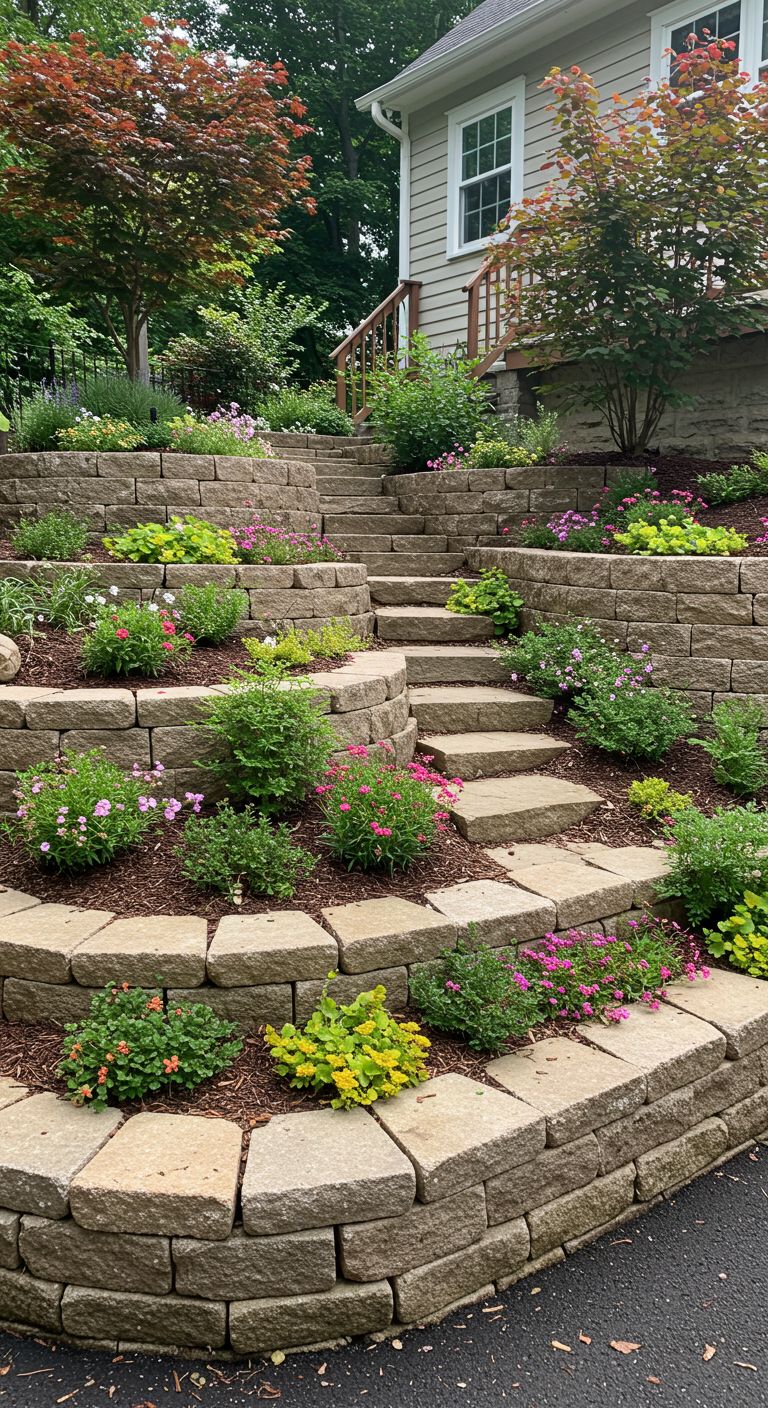
Even a slight slope can be tricky for planting and mowing. Turn it into a feature!
- Low retaining walls or terracing can make a big difference. Even one or two low ‘steps’ built from stone or timber can create level planting areas. These levels add instant architectural interest.
- Choose plants suited to slopes. Groundcovers help prevent erosion. Rock garden plants often thrive in well-drained sloping conditions. Select plants that can handle the specific drainage of your slope (top is drier, bottom is wetter).
Low Maintenance Realities
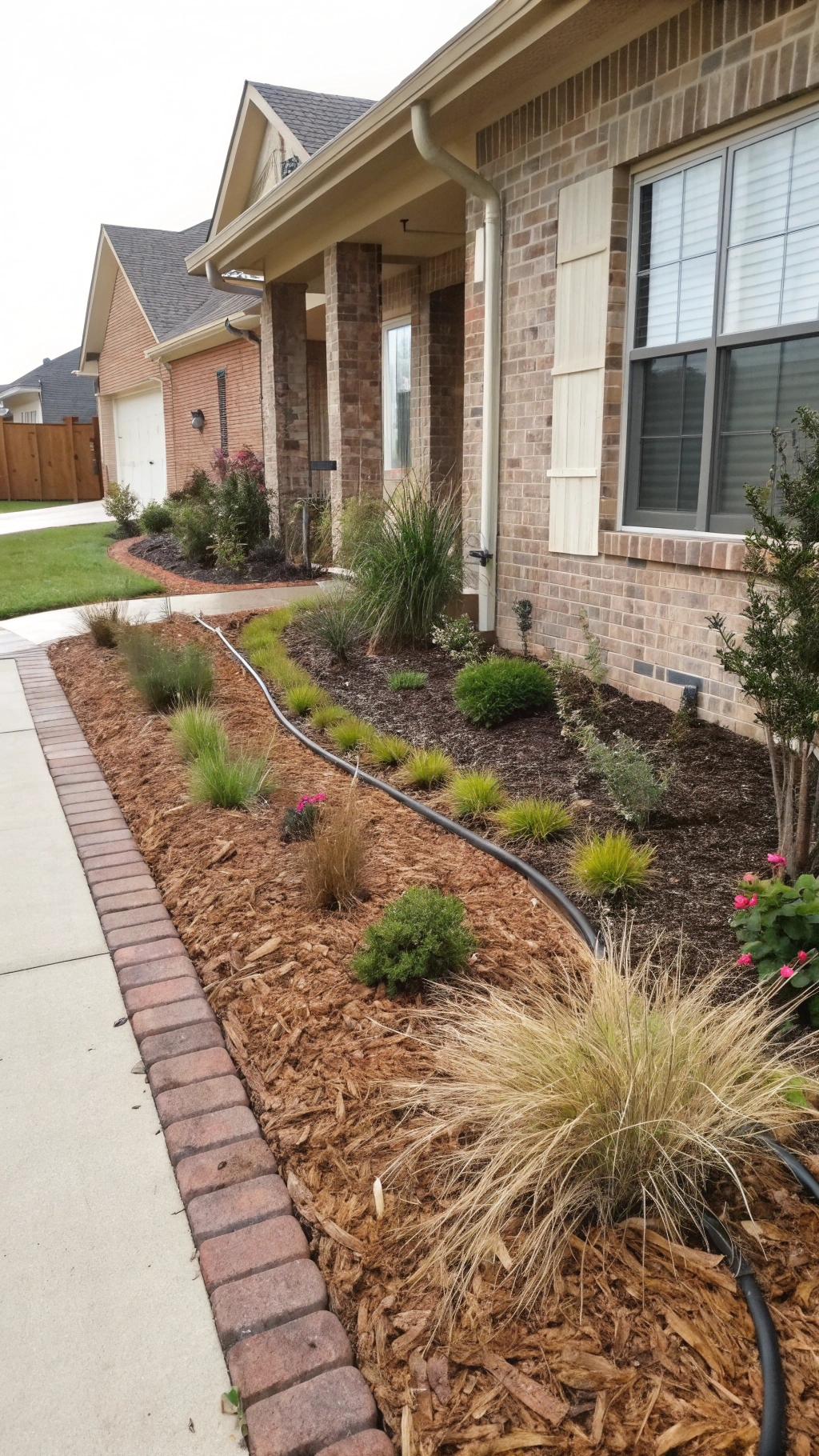
Let’s be honest. Most people want small front yard landscaping ideas low maintenance garden designs. Smart choices make this possible.
- Go back to plant selection. Choose drought-tolerant species once established. Consider native plants adapted to your local climate. Use fewer annuals (which need replacing yearly) and more perennials and shrubs.
- Apply mulch correctly. A 2-3 inch layer of organic mulch (like shredded bark) suppresses weeds, retains soil moisture, and improves the soil over time. Keep mulch away from direct contact with plant stems.
- Design for less lawn. Or no lawn at all! Replacing grass with groundcovers or expanded garden beds cuts mowing time drastically. This is often the biggest win for small front yard landscaping simple care.
- Consider simple irrigation. Drip lines or soaker hoses hidden under mulch deliver water directly to plant roots efficiently. They save water and your time compared to hand watering. These make small front yard landscaping easy.
DIY Potential: Projects for Impact
Ready to get your hands dirty? Many aspects of small front yard landscaping ideas diy projects are totally doable. Tackling some tasks yourself saves money. It also gives you a great sense of accomplishment. Focus on achievable wins first.
- Bed Preparation & Edging: Good soil is key. Digging in compost improves almost any soil. It helps drainage and gives plants nutrients. Then, install that clean edging. Metal, brick, or stone – choose your style. Getting the beds prepped and edged makes a huge difference. It looks instantly neater.
- Planting Techniques: Learn how to plant properly. Dig the right size hole. Tease out circling roots. Plant at the correct depth (usually level with the soil in the pot). Water well after planting. Doing this right helps your new plants thrive.
- Container Arrangements: Have fun with pots! Designing and planting stylish container groupings is creative work. Mix thrillers (tall focal plants), fillers (mounding plants), and spillers (trailing plants). Choose pots that fit your style. This is a great weekend project.
- Simple Pathway Installation: Creating a basic gravel or stepping stone path is often manageable. Mark out the path shape. Remove sod or soil. Add landscape fabric if needed. Spread gravel or set your stones. Check for level. A new path transforms how you use the space.
- Mulching: Easy and effective. Spreading mulch over your garden beds is simple. It suppresses weeds. Holds moisture. Looks tidy. Just remember to keep it a couple of inches away from plant stems.
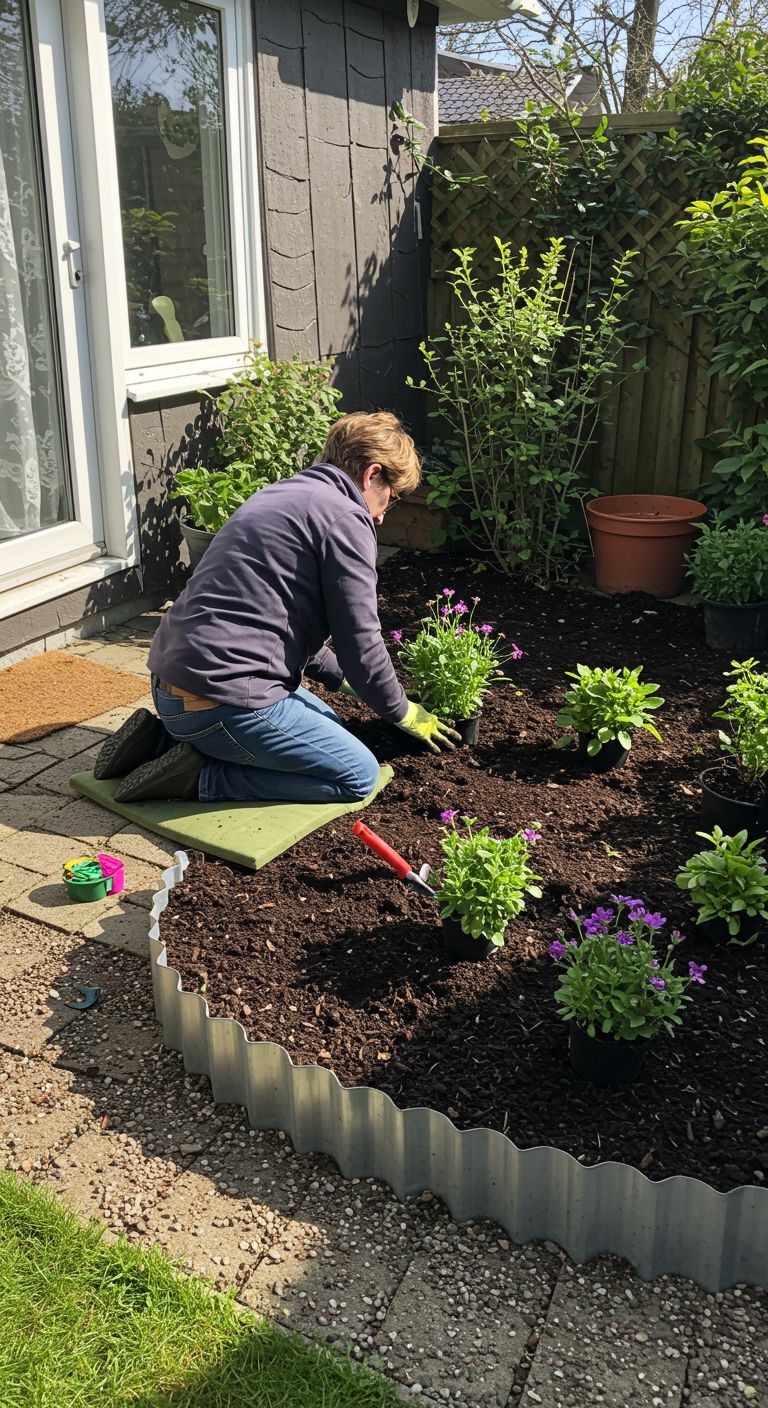
Planning is crucial for small front yard landscaping diy. Sketch out your ideas first. Even a simple drawing helps. Measure your space. Think about where plants will go. A plan prevents costly mistakes. It ensures everything works together.
Also, know your limits. Some jobs are best left to professionals. Major hardscaping like tall retaining walls needs expertise. Electrical work for lighting requires a licensed electrician. Significant grading changes often need pros too. Be realistic about what you can handle safely and well. But many small easy front yard landscaping ideas are perfect for DIY. Making small front yard landscaping ideas low maintenance diy a reality often starts with these steps.
Pulling It All Together: Your Small Yard Masterpiece
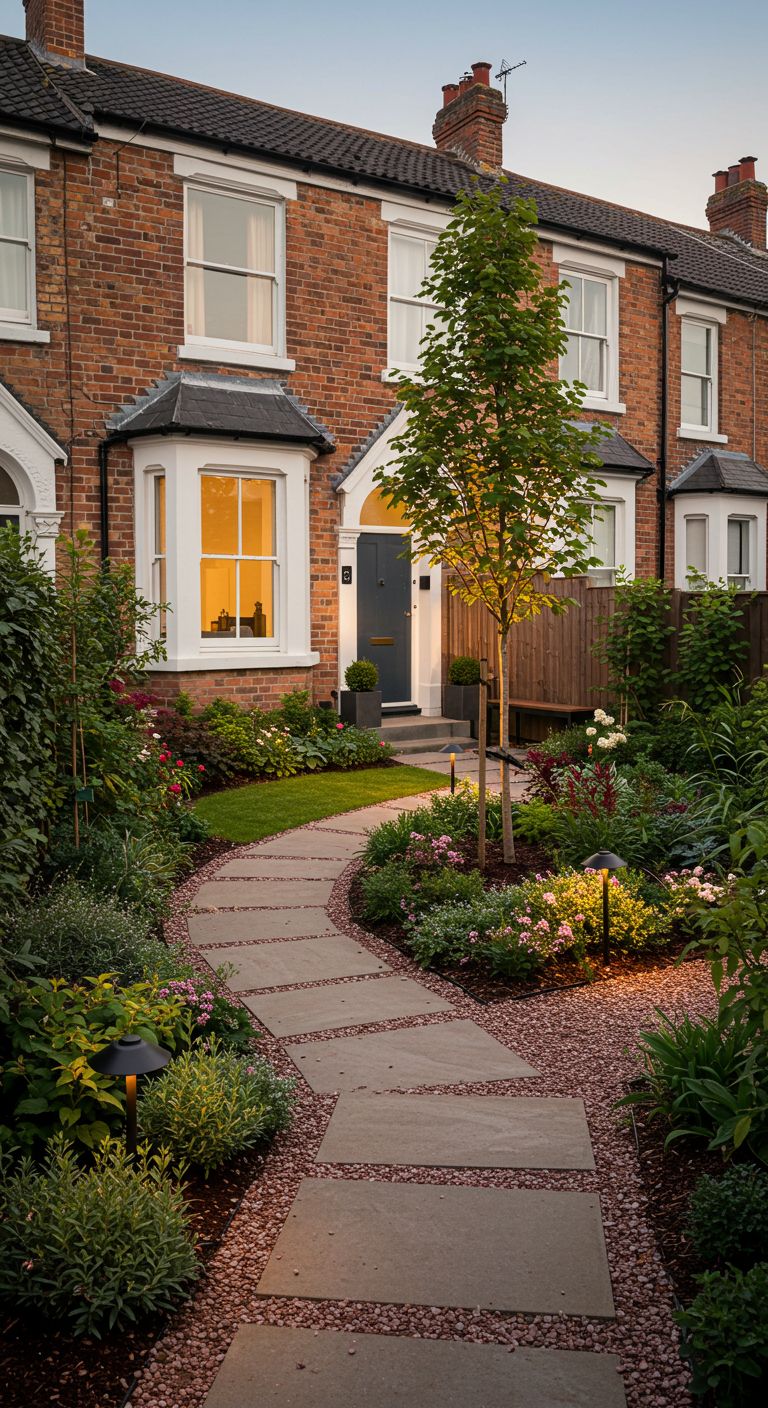
So, how do you make it all happen? It’s a process. First, you assess your space. Understand its size, shape, sunlight, and challenges. Then, you plan. Create that small front yard landscaping layout. Think about flow, focal points, and style. Next, you select your plants and materials carefully. Choose things that fit the design and your conditions. Finally, you implement your plan. Whether DIY or hiring help, bring the vision to life.
Remember the “Jewel Box” idea. Your small front yard is an opportunity. Focus on quality materials. Thoughtful design counts more than size. Every element should contribute. Every plant should earn its spot. Don’t try to cram in too much. Let your chosen features shine.
Make it yours. These ideas and principles are guides. Adapt them to your personal style. Match them to your home’s character. Do you love modern design? Cottage gardens? Native plants? Let your personality show through. The best small yards reflect the people who live there. They feel authentic.
Final Thoughts: Embrace Your Space, Inspire Your Street
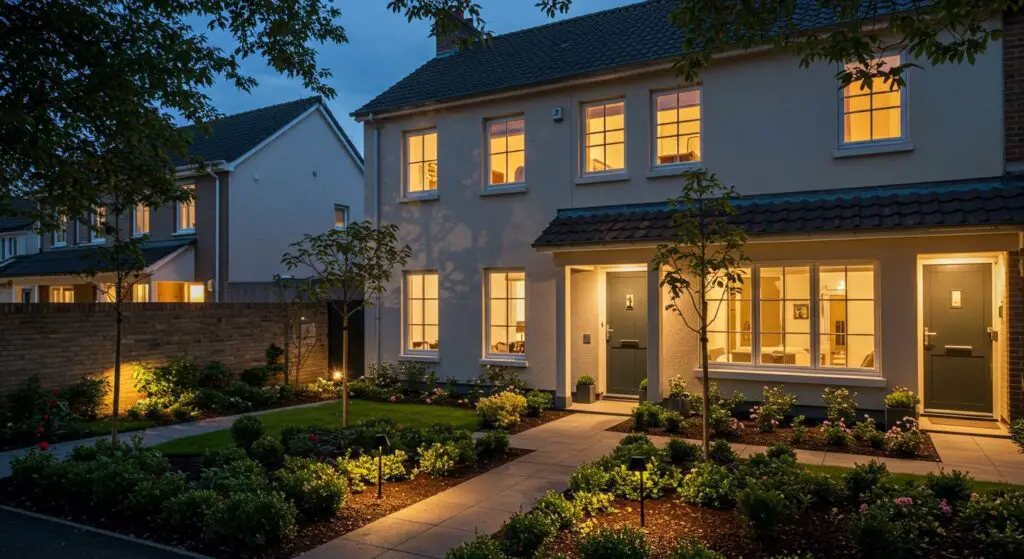
Don’t let a small front yard discourage you. See its potential. Embrace the challenge. With smart design and careful choices, you can create something truly special. A small space doesn’t mean small impact. Often, the most charming and memorable gardens are the most intimate ones.
Think of the transformation. From a forgotten patch to a welcoming introduction. From basic builder landscaping to a stylish statement. Your front yard can become a source of pride. A place that enhances your home’s curb appeal. A garden that inspires neighbours. It can be functional, beautiful, and uniquely yours.
So start dreaming. Start planning. Start planting! That small space holds immense possibilities. Create a front yard masterpiece that welcomes you home every single day. Make it a jewel box that shines on your street.
